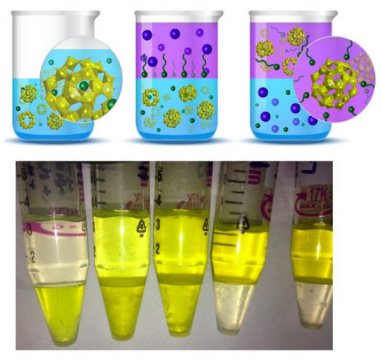Feb
1
A New Better Safer Way to Extract Uranium
February 1, 2017 | 2 Comments
The new technique uses soap-like chemicals known as surfactants to extract uranium from an aqueous solution into a kerosene solution in the form of hollow clusters. Aside from fuel preparation, it may also find value in legacy waste treatment and for the cleanup of environmental contamination.

A diagram, top, and photograph show uranium clusters being extracted upward from an aqueous solution into a kerosene solution. Image Credit: Oregon State University. Click image for the largest view.
The research at OSU involves a unique form of uranium discovered in 2005, uranyl peroxide capsules, and how those negatively charged clusters form in alkaline conditions. The team’s research paper, prepared in a collaboration with scientists from the University of Notre Dame, has been published in the European Journal of Inorganic Chemistry.
Study lead author Harrison Neal, a graduate student in Oregon State’s College of Science said, “This is a very different direction. A lot of the work done now is in acid, and we’re at the other end of the pH scale in base. It’s a very different approach, overall using less harmful, less toxic chemicals.”
Throughout the nuclear fuel cycle, many separations are required – in mining, enrichment and fuel fabrication, and then after fuel use, for the recovery of usable spent isotopes and the encapsulation and storage of unusable radioactive components.
May Nyman, professor of chemistry at Oregon State and corresponding author on the research explains, “When you use nuclear fuel, the radioactive decay products poison the fuel and make it less effective. You have to take it, dissolve it, get the good stuff out and make new fuel.”
Nyman notes the work represents significant fundamental research in the field of cluster chemistry because it allows for the study of uranyl clusters in the organic phase and can pave the way to improved understanding of ion association.
Neal takes this concept further and explained, “With extracting these clusters into the organic phase, the clusters themselves are hollow, so when we get them into the organic solution, they’re still containing other atoms, molecules, other ions. We can study how these ions interact with these cages that they’re in. The fundamental research is understanding how the ions get inside and what they do once they’re inside because they’re stuck there.”
When the clusters form, each contains 20 to 60 uranium atoms, “so we can extract them in whole bunches instead of one at a time,” Nyman said. “It’s an atom-efficient approach.”
Existing separation techniques require two extraction molecules for every uranium ion, whereas the OSU technique requires less than one extraction molecule per ion.
Admittedly, this is a narrow field, but the separation technology could be huge if the U.S. and other countries wake up to the alternate reactor plans available. For even more motivation, look at the recycling and waste treatment potential.
Nothing other than fusion offers more energy for the fuel than nuclear fission using uranium. Now, the next question is, will this technology have application to plutonium?
Comments
2 Comments so far


If you only looked at the pictures you would think they were using sperm to separate Uranium.
But seriously, I wonder if this same process could be used to separate gold?
Excellent Question! May be more here than the team thought at writing the paper.